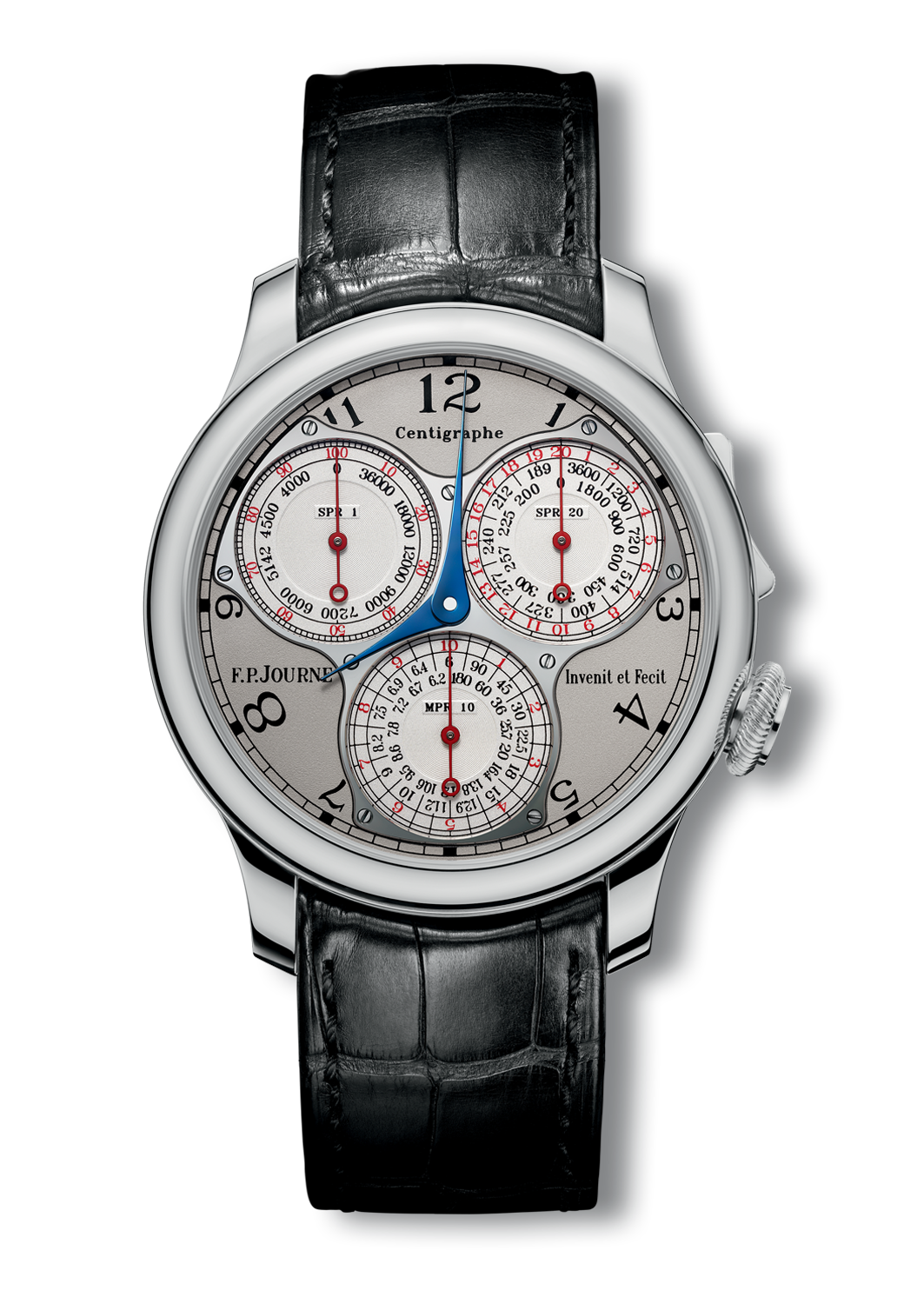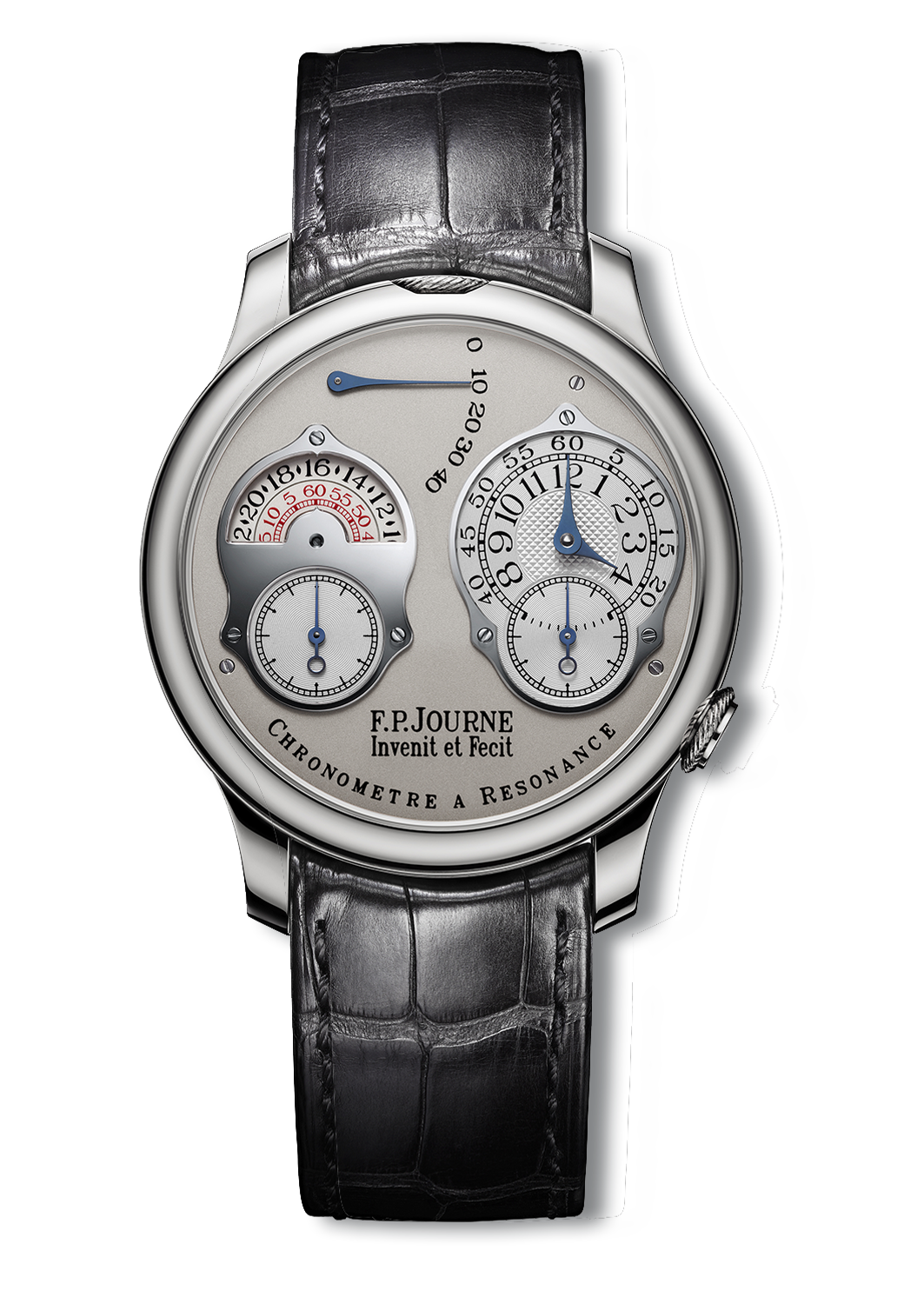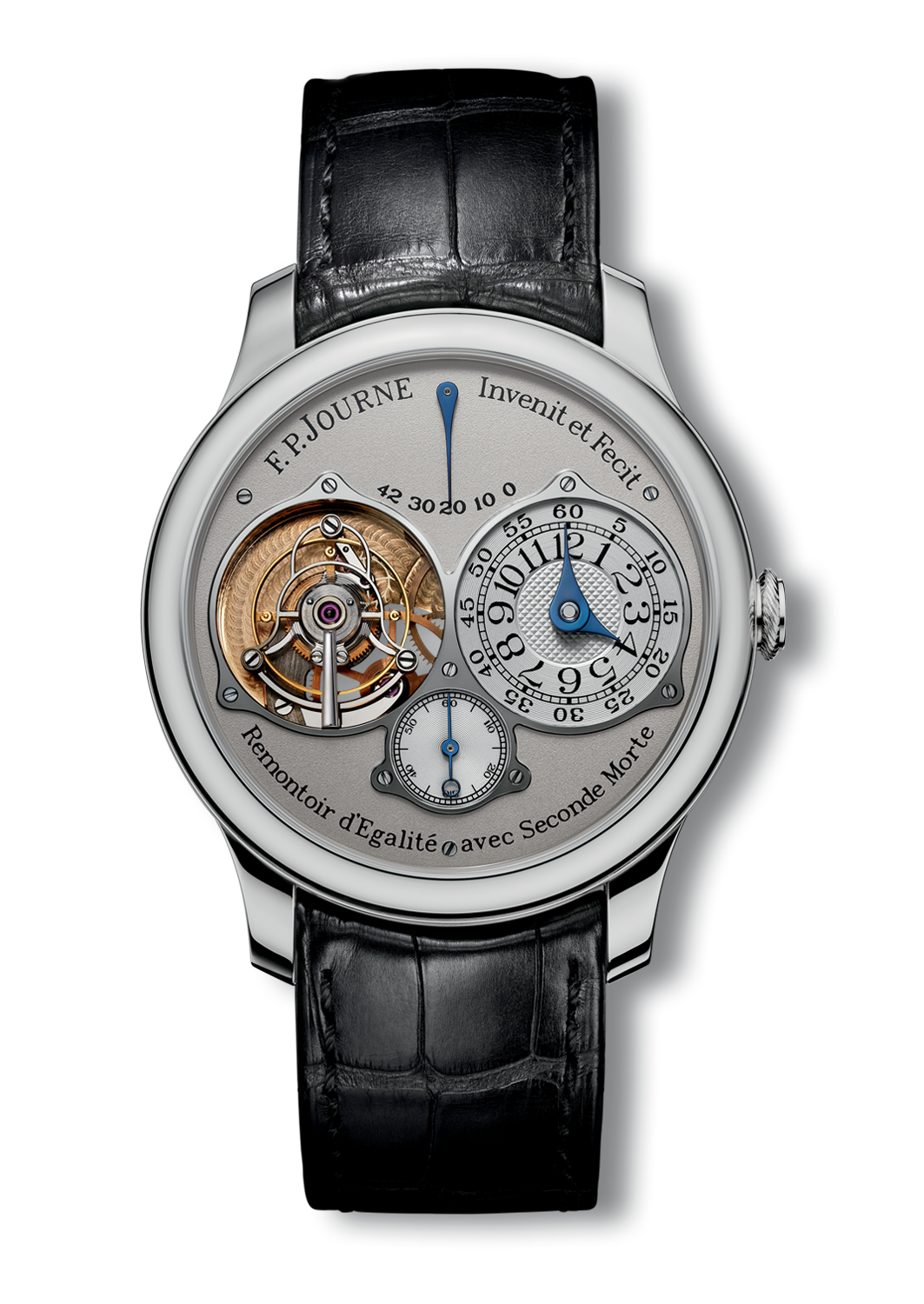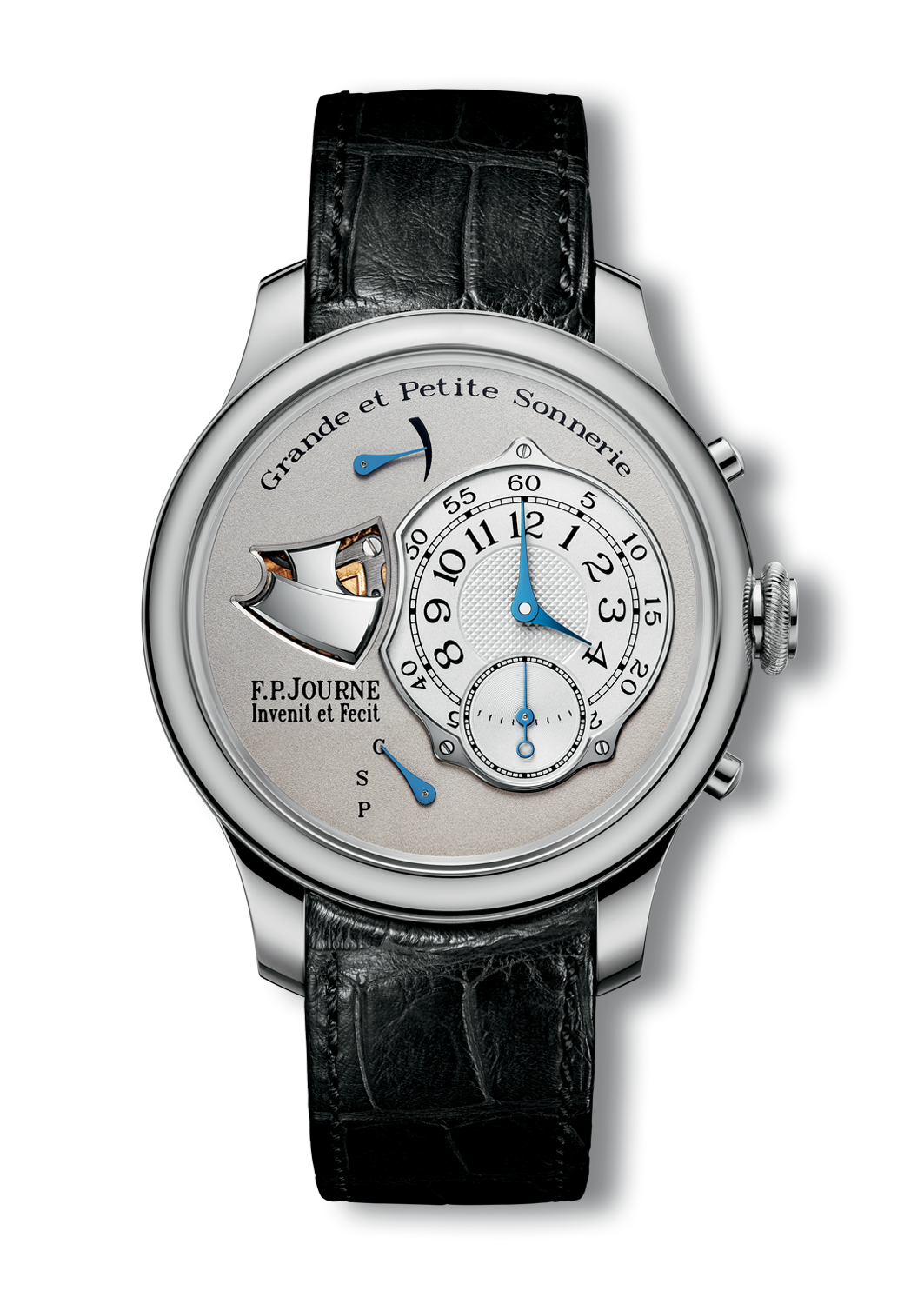Calibre 1499.2 https://www.fpjourne.com/en/collection/souveraine-collection/chronometre-resonance FP Journe https://www.fpjourne.com/en FP Journe
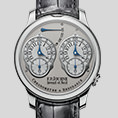
Diameter: 40 mm
Overall height: 9.1 mm
Dial: white Gold and whitened guilloché Silver, double display (analog 12 hours)
Hands: blued Steel
Technical Specifications
- Winding : Manual
- 18K rose gold : 36 jewels
- Overall diameter : 32.60 mm
- Casing-up diameter : 32.0 mm
- Overall height : 4.50 mm
- Height of winding system : 2.59 mm
- Diameter of stem thread : S1.00mm
- Diameter of reset to zero stem : S1.20mm
2 x linear escapements, 15 teeth
2 x balances with 4 inertia weight
2 x flat microflamed Anachron balance Spring
2 x mobile stud carriers
2 x free sprung balance springs
2x spring laser pinned to Nivatronic collets
Pinned GE studs
2 position winding crown
Reset to zero button for seconds
21 600 Alt/h (3Hz)
10.10 mg/cm2
52°
0h dial up: 320°
24h dial up: 270°
Manual winding, 27 turns of crown
Time adjustment at 12h for left dial by winding crown on position 2 in one direction, and in the opposite direction for right dial
Reset both seconds to zero by pulling button at 4h00
Double display:
Left dial –digital - indicating 24 hours
Right dial – analogic- indicating 12 hours
2 small seconds at 6h00
Power reserve at 11h00
40 ± 2 hours
High quality
Partial circular graining on baseplate
Screw heads polished and bevelled, with chamfered slots
Pegs with polished rounded ends
Movement without dial: 299
Cased up with strap: 336
- Winding : Manual
- 18K rose gold : 36 jewels
- Overall diameter : 32.60 mm
- Casing-up diameter : 32.0 mm
- Overall height : 4.50 mm
- Height of winding system : 2.59 mm
- Diameter of stem thread : S1.00mm
- Diameter of reset to zero stem : S1.20mm
2 x linear escapements, 15 teeth
2 x balances with 4 inertia weight
2 x flat microflamed Anachron balance Spring
2 x mobile stud carriers
2 x free sprung balance springs
2x spring laser pinned to Nivatronic collets
Pinned GE studs
2 position winding crown
Reset to zero button for seconds
21 600 Alt/h (3Hz)
10.10 mg/cm2
52°
0h dial up: 320°
24h dial up: 270°
Manual winding, 27 turns of crown
Time adjustment at 12h for left dial by winding crown on position 2 in one direction, and in the opposite direction for right dial
Reset both seconds to zero by pulling button at 4h00
Double display:
Left dial –digital - indicating 24 hours
Right dial – analogic- indicating 12 hours
2 small seconds at 6h00
Power reserve at 11h00
40 ± 2 hours
High quality
Partial circular graining on baseplate
Screw heads polished and bevelled, with chamfered slots
Pegs with polished rounded ends
Movement without dial: 299
Cased up with strap: 336
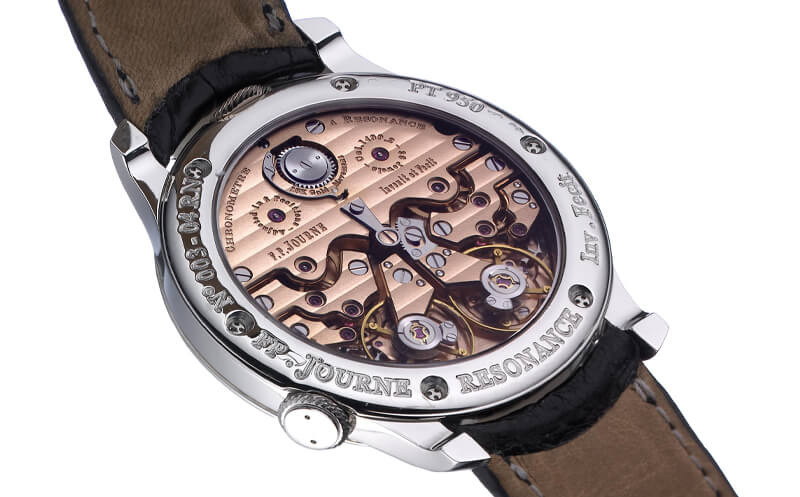
Technical description
François-Paul Journe pays tribute to the research conducted on resonance by the great 18th century watchmakers, with the presentation of the first wristwatch resonance chronometer.
In 1983, François-Paul Journe took up the challenge with a first creation in the form of a pocket-watch, which did not yet perform according to his expectations. It would take fifteen more years of work for the watchmaker to gain the maturity and the experience to enable him to present an exclusive world première, the first resonance wristwatch.

Technical description
François-Paul Journe pays tribute to the research conducted on resonance by the great 18th century watchmakers, with the presentation of the first wristwatch resonance chronometer.
In 1983, François-Paul Journe took up the challenge with a first creation in the form of a pocket-watch, which did not yet perform according to his expectations. It would take fifteen more years of work for the watchmaker to gain the maturity and the experience to enable him to present an exclusive world première, the first resonance wristwatch.
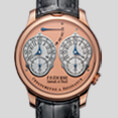
Diameter: 40 mm
Overall height: 9.1 mm
Dial: 18K 6N Gold and whitened guilloché Silver, double display (analog 12 hours)
Hands: blued Steel
Technical Specifications
- Winding : Manual
- 18K rose gold : 36 jewels
- Overall diameter : 32.60 mm
- Casing-up diameter : 32.0 mm
- Overall height : 4.50 mm
- Height of winding system : 2.59 mm
- Diameter of stem thread : S1.00mm
- Diameter of reset to zero stem : S1.20mm
2 x linear escapements, 15 teeth
2 x balances with 4 inertia weight
2 x flat microflamed Anachron balance Spring
2 x mobile stud carriers
2 x free sprung balance springs
2x spring laser pinned to Nivatronic collets
Pinned GE studs
2 position winding crown
Reset to zero button for seconds
21 600 Alt/h (3Hz)
10.10 mg/cm2
52°
0h dial up: 320°
24h dial up: 270°
Manual winding, 27 turns of crown
Time adjustment at 12h for left dial by winding crown on position 2 in one direction, and in the opposite direction for right dial
Reset both seconds to zero by pulling button at 4h00
Double display:
Left dial –digital - indicating 24 hours
Right dial – analogic- indicating 12 hours
2 small seconds at 6h00
Power reserve at 11h00
40 ± 2 hours
High quality
Partial circular graining on baseplate
Screw heads polished and bevelled, with chamfered slots
Pegs with polished rounded ends
Movement without dial: 299
Cased up with strap: 336
- Winding : Manual
- 18K rose gold : 36 jewels
- Overall diameter : 32.60 mm
- Casing-up diameter : 32.0 mm
- Overall height : 4.50 mm
- Height of winding system : 2.59 mm
- Diameter of stem thread : S1.00mm
- Diameter of reset to zero stem : S1.20mm
2 x linear escapements, 15 teeth
2 x balances with 4 inertia weight
2 x flat microflamed Anachron balance Spring
2 x mobile stud carriers
2 x free sprung balance springs
2x spring laser pinned to Nivatronic collets
Pinned GE studs
2 position winding crown
Reset to zero button for seconds
21 600 Alt/h (3Hz)
10.10 mg/cm2
52°
0h dial up: 320°
24h dial up: 270°
Manual winding, 27 turns of crown
Time adjustment at 12h for left dial by winding crown on position 2 in one direction, and in the opposite direction for right dial
Reset both seconds to zero by pulling button at 4h00
Double display:
Left dial –digital - indicating 24 hours
Right dial – analogic- indicating 12 hours
2 small seconds at 6h00
Power reserve at 11h00
40 ± 2 hours
High quality
Partial circular graining on baseplate
Screw heads polished and bevelled, with chamfered slots
Pegs with polished rounded ends
Movement without dial: 299
Cased up with strap: 336

Technical description
François-Paul Journe pays tribute to the research conducted on resonance by the great 18th century watchmakers, with the presentation of the first wristwatch resonance chronometer.
In 1983, François-Paul Journe took up the challenge with a first creation in the form of a pocket-watch, which did not yet perform according to his expectations. It would take fifteen more years of work for the watchmaker to gain the maturity and the experience to enable him to present an exclusive world première, the first resonance wristwatch.

Technical description
François-Paul Journe pays tribute to the research conducted on resonance by the great 18th century watchmakers, with the presentation of the first wristwatch resonance chronometer.
In 1983, François-Paul Journe took up the challenge with a first creation in the form of a pocket-watch, which did not yet perform according to his expectations. It would take fifteen more years of work for the watchmaker to gain the maturity and the experience to enable him to present an exclusive world première, the first resonance wristwatch.
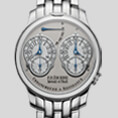
Diameter: 40 mm
Overall height: 9.1 mm
Dial: white Gold and whitened guilloché Silver, double display (analog 12 hours)
Hands: blued Steel
Technical Specifications
- Winding : Manual
- 18K rose gold : 36 jewels
- Overall diameter : 32.60 mm
- Casing-up diameter : 32.0 mm
- Overall height : 4.50 mm
- Height of winding system : 2.59 mm
- Diameter of stem thread : S1.00mm
- Diameter of reset to zero stem : S1.20mm
2 x linear escapements, 15 teeth
2 x balances with 4 inertia weight
2 x flat microflamed Anachron balance Spring
2 x mobile stud carriers
2 x free sprung balance springs
2x spring laser pinned to Nivatronic collets
Pinned GE studs
2 position winding crown
Reset to zero button for seconds
21 600 Alt/h (3Hz)
10.10 mg/cm2
52°
0h dial up: 320°
24h dial up: 270°
Manual winding, 27 turns of crown
Time adjustment at 12h for left dial by winding crown on position 2 in one direction, and in the opposite direction for right dial
Reset both seconds to zero by pulling button at 4h00
Double display:
Left dial –digital - indicating 24 hours
Right dial – analogic- indicating 12 hours
2 small seconds at 6h00
Power reserve at 11h00
40 ± 2 hours
High quality
Partial circular graining on baseplate
Screw heads polished and bevelled, with chamfered slots
Pegs with polished rounded ends
Movement without dial: 299
Cased up with strap: 336
- Winding : Manual
- 18K rose gold : 36 jewels
- Overall diameter : 32.60 mm
- Casing-up diameter : 32.0 mm
- Overall height : 4.50 mm
- Height of winding system : 2.59 mm
- Diameter of stem thread : S1.00mm
- Diameter of reset to zero stem : S1.20mm
2 x linear escapements, 15 teeth
2 x balances with 4 inertia weight
2 x flat microflamed Anachron balance Spring
2 x mobile stud carriers
2 x free sprung balance springs
2x spring laser pinned to Nivatronic collets
Pinned GE studs
2 position winding crown
Reset to zero button for seconds
21 600 Alt/h (3Hz)
10.10 mg/cm2
52°
0h dial up: 320°
24h dial up: 270°
Manual winding, 27 turns of crown
Time adjustment at 12h for left dial by winding crown on position 2 in one direction, and in the opposite direction for right dial
Reset both seconds to zero by pulling button at 4h00
Double display:
Left dial –digital - indicating 24 hours
Right dial – analogic- indicating 12 hours
2 small seconds at 6h00
Power reserve at 11h00
40 ± 2 hours
High quality
Partial circular graining on baseplate
Screw heads polished and bevelled, with chamfered slots
Pegs with polished rounded ends
Movement without dial: 299
Cased up with strap: 336

Technical description
François-Paul Journe pays tribute to the research conducted on resonance by the great 18th century watchmakers, with the presentation of the first wristwatch resonance chronometer.
In 1983, François-Paul Journe took up the challenge with a first creation in the form of a pocket-watch, which did not yet perform according to his expectations. It would take fifteen more years of work for the watchmaker to gain the maturity and the experience to enable him to present an exclusive world première, the first resonance wristwatch.

Technical description
François-Paul Journe pays tribute to the research conducted on resonance by the great 18th century watchmakers, with the presentation of the first wristwatch resonance chronometer.
In 1983, François-Paul Journe took up the challenge with a first creation in the form of a pocket-watch, which did not yet perform according to his expectations. It would take fifteen more years of work for the watchmaker to gain the maturity and the experience to enable him to present an exclusive world première, the first resonance wristwatch.
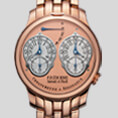
Diameter: 40 mm
Overall height: 9.1 mm
Dial: 18K 6N Gold and whitened guilloché Silver, double display (analog 12 hours)
Hands: blued Steel
Technical Specifications
- Winding : Manual
- 18K rose gold : 36 jewels
- Overall diameter : 32.60 mm
- Casing-up diameter : 32.0 mm
- Overall height : 4.50 mm
- Height of winding system : 2.59 mm
- Diameter of stem thread : S1.00mm
- Diameter of reset to zero stem : S1.20mm
2 x linear escapements, 15 teeth
2 x balances with 4 inertia weight
2 x flat microflamed Anachron balance Spring
2 x mobile stud carriers
2 x free sprung balance springs
2x spring laser pinned to Nivatronic collets
Pinned GE studs
2 position winding crown
Reset to zero button for seconds
21 600 Alt/h (3Hz)
10.10 mg/cm2
52°
0h dial up: 320°
24h dial up: 270°
Manual winding, 27 turns of crown
Time adjustment at 12h for left dial by winding crown on position 2 in one direction, and in the opposite direction for right dial
Reset both seconds to zero by pulling button at 4h00
Double display:
Left dial –digital - indicating 24 hours
Right dial – analogic- indicating 12 hours
2 small seconds at 6h00
Power reserve at 11h00
40 ± 2 hours
High quality
Partial circular graining on baseplate
Screw heads polished and bevelled, with chamfered slots
Pegs with polished rounded ends
Movement without dial: 299
Cased up with strap: 336
- Winding : Manual
- 18K rose gold : 36 jewels
- Overall diameter : 32.60 mm
- Casing-up diameter : 32.0 mm
- Overall height : 4.50 mm
- Height of winding system : 2.59 mm
- Diameter of stem thread : S1.00mm
- Diameter of reset to zero stem : S1.20mm
2 x linear escapements, 15 teeth
2 x balances with 4 inertia weight
2 x flat microflamed Anachron balance Spring
2 x mobile stud carriers
2 x free sprung balance springs
2x spring laser pinned to Nivatronic collets
Pinned GE studs
2 position winding crown
Reset to zero button for seconds
21 600 Alt/h (3Hz)
10.10 mg/cm2
52°
0h dial up: 320°
24h dial up: 270°
Manual winding, 27 turns of crown
Time adjustment at 12h for left dial by winding crown on position 2 in one direction, and in the opposite direction for right dial
Reset both seconds to zero by pulling button at 4h00
Double display:
Left dial –digital - indicating 24 hours
Right dial – analogic- indicating 12 hours
2 small seconds at 6h00
Power reserve at 11h00
40 ± 2 hours
High quality
Partial circular graining on baseplate
Screw heads polished and bevelled, with chamfered slots
Pegs with polished rounded ends
Movement without dial: 299
Cased up with strap: 336

Technical description
François-Paul Journe pays tribute to the research conducted on resonance by the great 18th century watchmakers, with the presentation of the first wristwatch resonance chronometer.
In 1983, François-Paul Journe took up the challenge with a first creation in the form of a pocket-watch, which did not yet perform according to his expectations. It would take fifteen more years of work for the watchmaker to gain the maturity and the experience to enable him to present an exclusive world première, the first resonance wristwatch.

Technical description
François-Paul Journe pays tribute to the research conducted on resonance by the great 18th century watchmakers, with the presentation of the first wristwatch resonance chronometer.
In 1983, François-Paul Journe took up the challenge with a first creation in the form of a pocket-watch, which did not yet perform according to his expectations. It would take fifteen more years of work for the watchmaker to gain the maturity and the experience to enable him to present an exclusive world première, the first resonance wristwatch.
Diameter: 40 mm
Overall height: 9.1 mm
Dial: white Gold and whitened guilloché Silver, double display (analog 12 hours)
Hands: blued Steel

Diameter: 40 mm
Overall height: 9.1 mm
Dial: white Gold and whitened guilloché Silver, double display (analog 12 hours)
Hands: blued Steel
Technical Specifications
- Winding : Manual
- 18K rose gold : 36 jewels
- Overall diameter : 32.60 mm
- Casing-up diameter : 32.0 mm
- Overall height : 4.50 mm
- Height of winding system : 2.59 mm
- Diameter of stem thread : S1.00mm
- Diameter of reset to zero stem : S1.20mm
2 x linear escapements, 15 teeth
2 x balances with 4 inertia weight
2 x flat microflamed Anachron balance Spring
2 x mobile stud carriers
2 x free sprung balance springs
2x spring laser pinned to Nivatronic collets
Pinned GE studs
2 position winding crown
Reset to zero button for seconds
21 600 Alt/h (3Hz)
10.10 mg/cm2
52°
0h dial up: 320°
24h dial up: 270°
Manual winding, 27 turns of crown
Time adjustment at 12h for left dial by winding crown on position 2 in one direction, and in the opposite direction for right dial
Reset both seconds to zero by pulling button at 4h00
Double display:
Left dial –digital - indicating 24 hours
Right dial – analogic- indicating 12 hours
2 small seconds at 6h00
Power reserve at 11h00
40 ± 2 hours
High quality
Partial circular graining on baseplate
Screw heads polished and bevelled, with chamfered slots
Pegs with polished rounded ends
Movement without dial: 299
Cased up with strap: 336
- Winding : Manual
- 18K rose gold : 36 jewels
- Overall diameter : 32.60 mm
- Casing-up diameter : 32.0 mm
- Overall height : 4.50 mm
- Height of winding system : 2.59 mm
- Diameter of stem thread : S1.00mm
- Diameter of reset to zero stem : S1.20mm
2 x linear escapements, 15 teeth
2 x balances with 4 inertia weight
2 x flat microflamed Anachron balance Spring
2 x mobile stud carriers
2 x free sprung balance springs
2x spring laser pinned to Nivatronic collets
Pinned GE studs
2 position winding crown
Reset to zero button for seconds
21 600 Alt/h (3Hz)
10.10 mg/cm2
52°
0h dial up: 320°
24h dial up: 270°
Manual winding, 27 turns of crown
Time adjustment at 12h for left dial by winding crown on position 2 in one direction, and in the opposite direction for right dial
Reset both seconds to zero by pulling button at 4h00
Double display:
Left dial –digital - indicating 24 hours
Right dial – analogic- indicating 12 hours
2 small seconds at 6h00
Power reserve at 11h00
40 ± 2 hours
High quality
Partial circular graining on baseplate
Screw heads polished and bevelled, with chamfered slots
Pegs with polished rounded ends
Movement without dial: 299
Cased up with strap: 336

Technical description
François-Paul Journe pays tribute to the research conducted on resonance by the great 18th century watchmakers, with the presentation of the first wristwatch resonance chronometer.
In 1983, François-Paul Journe took up the challenge with a first creation in the form of a pocket-watch, which did not yet perform according to his expectations. It would take fifteen more years of work for the watchmaker to gain the maturity and the experience to enable him to present an exclusive world première, the first resonance wristwatch.

Technical description
François-Paul Journe pays tribute to the research conducted on resonance by the great 18th century watchmakers, with the presentation of the first wristwatch resonance chronometer.
In 1983, François-Paul Journe took up the challenge with a first creation in the form of a pocket-watch, which did not yet perform according to his expectations. It would take fifteen more years of work for the watchmaker to gain the maturity and the experience to enable him to present an exclusive world première, the first resonance wristwatch.

Diameter: 40 mm
Overall height: 9.1 mm
Dial: 18K 6N Gold and whitened guilloché Silver, double display (analog 12 hours)
Hands: blued Steel
Technical Specifications
- Winding : Manual
- 18K rose gold : 36 jewels
- Overall diameter : 32.60 mm
- Casing-up diameter : 32.0 mm
- Overall height : 4.50 mm
- Height of winding system : 2.59 mm
- Diameter of stem thread : S1.00mm
- Diameter of reset to zero stem : S1.20mm
2 x linear escapements, 15 teeth
2 x balances with 4 inertia weight
2 x flat microflamed Anachron balance Spring
2 x mobile stud carriers
2 x free sprung balance springs
2x spring laser pinned to Nivatronic collets
Pinned GE studs
2 position winding crown
Reset to zero button for seconds
21 600 Alt/h (3Hz)
10.10 mg/cm2
52°
0h dial up: 320°
24h dial up: 270°
Manual winding, 27 turns of crown
Time adjustment at 12h for left dial by winding crown on position 2 in one direction, and in the opposite direction for right dial
Reset both seconds to zero by pulling button at 4h00
Double display:
Left dial –digital - indicating 24 hours
Right dial – analogic- indicating 12 hours
2 small seconds at 6h00
Power reserve at 11h00
40 ± 2 hours
High quality
Partial circular graining on baseplate
Screw heads polished and bevelled, with chamfered slots
Pegs with polished rounded ends
Movement without dial: 299
Cased up with strap: 336
- Winding : Manual
- 18K rose gold : 36 jewels
- Overall diameter : 32.60 mm
- Casing-up diameter : 32.0 mm
- Overall height : 4.50 mm
- Height of winding system : 2.59 mm
- Diameter of stem thread : S1.00mm
- Diameter of reset to zero stem : S1.20mm
2 x linear escapements, 15 teeth
2 x balances with 4 inertia weight
2 x flat microflamed Anachron balance Spring
2 x mobile stud carriers
2 x free sprung balance springs
2x spring laser pinned to Nivatronic collets
Pinned GE studs
2 position winding crown
Reset to zero button for seconds
21 600 Alt/h (3Hz)
10.10 mg/cm2
52°
0h dial up: 320°
24h dial up: 270°
Manual winding, 27 turns of crown
Time adjustment at 12h for left dial by winding crown on position 2 in one direction, and in the opposite direction for right dial
Reset both seconds to zero by pulling button at 4h00
Double display:
Left dial –digital - indicating 24 hours
Right dial – analogic- indicating 12 hours
2 small seconds at 6h00
Power reserve at 11h00
40 ± 2 hours
High quality
Partial circular graining on baseplate
Screw heads polished and bevelled, with chamfered slots
Pegs with polished rounded ends
Movement without dial: 299
Cased up with strap: 336

Technical description
François-Paul Journe pays tribute to the research conducted on resonance by the great 18th century watchmakers, with the presentation of the first wristwatch resonance chronometer.
In 1983, François-Paul Journe took up the challenge with a first creation in the form of a pocket-watch, which did not yet perform according to his expectations. It would take fifteen more years of work for the watchmaker to gain the maturity and the experience to enable him to present an exclusive world première, the first resonance wristwatch.

Technical description
François-Paul Journe pays tribute to the research conducted on resonance by the great 18th century watchmakers, with the presentation of the first wristwatch resonance chronometer.
In 1983, François-Paul Journe took up the challenge with a first creation in the form of a pocket-watch, which did not yet perform according to his expectations. It would take fifteen more years of work for the watchmaker to gain the maturity and the experience to enable him to present an exclusive world première, the first resonance wristwatch.

Diameter: 40 mm
Overall height: 9.1 mm
Dial: white Gold and whitened guilloché Silver, double display (analog 12 hours)
Hands: blued Steel
Technical Specifications
- Winding : Manual
- 18K rose gold : 36 jewels
- Overall diameter : 32.60 mm
- Casing-up diameter : 32.0 mm
- Overall height : 4.50 mm
- Height of winding system : 2.59 mm
- Diameter of stem thread : S1.00mm
- Diameter of reset to zero stem : S1.20mm
2 x linear escapements, 15 teeth
2 x balances with 4 inertia weight
2 x flat microflamed Anachron balance Spring
2 x mobile stud carriers
2 x free sprung balance springs
2x spring laser pinned to Nivatronic collets
Pinned GE studs
2 position winding crown
Reset to zero button for seconds
21 600 Alt/h (3Hz)
10.10 mg/cm2
52°
0h dial up: 320°
24h dial up: 270°
Manual winding, 27 turns of crown
Time adjustment at 12h for left dial by winding crown on position 2 in one direction, and in the opposite direction for right dial
Reset both seconds to zero by pulling button at 4h00
Double display:
Left dial –digital - indicating 24 hours
Right dial – analogic- indicating 12 hours
2 small seconds at 6h00
Power reserve at 11h00
40 ± 2 hours
High quality
Partial circular graining on baseplate
Screw heads polished and bevelled, with chamfered slots
Pegs with polished rounded ends
Movement without dial: 299
Cased up with strap: 336
- Winding : Manual
- 18K rose gold : 36 jewels
- Overall diameter : 32.60 mm
- Casing-up diameter : 32.0 mm
- Overall height : 4.50 mm
- Height of winding system : 2.59 mm
- Diameter of stem thread : S1.00mm
- Diameter of reset to zero stem : S1.20mm
2 x linear escapements, 15 teeth
2 x balances with 4 inertia weight
2 x flat microflamed Anachron balance Spring
2 x mobile stud carriers
2 x free sprung balance springs
2x spring laser pinned to Nivatronic collets
Pinned GE studs
2 position winding crown
Reset to zero button for seconds
21 600 Alt/h (3Hz)
10.10 mg/cm2
52°
0h dial up: 320°
24h dial up: 270°
Manual winding, 27 turns of crown
Time adjustment at 12h for left dial by winding crown on position 2 in one direction, and in the opposite direction for right dial
Reset both seconds to zero by pulling button at 4h00
Double display:
Left dial –digital - indicating 24 hours
Right dial – analogic- indicating 12 hours
2 small seconds at 6h00
Power reserve at 11h00
40 ± 2 hours
High quality
Partial circular graining on baseplate
Screw heads polished and bevelled, with chamfered slots
Pegs with polished rounded ends
Movement without dial: 299
Cased up with strap: 336

Technical description
François-Paul Journe pays tribute to the research conducted on resonance by the great 18th century watchmakers, with the presentation of the first wristwatch resonance chronometer.
In 1983, François-Paul Journe took up the challenge with a first creation in the form of a pocket-watch, which did not yet perform according to his expectations. It would take fifteen more years of work for the watchmaker to gain the maturity and the experience to enable him to present an exclusive world première, the first resonance wristwatch.

Technical description
François-Paul Journe pays tribute to the research conducted on resonance by the great 18th century watchmakers, with the presentation of the first wristwatch resonance chronometer.
In 1983, François-Paul Journe took up the challenge with a first creation in the form of a pocket-watch, which did not yet perform according to his expectations. It would take fifteen more years of work for the watchmaker to gain the maturity and the experience to enable him to present an exclusive world première, the first resonance wristwatch.

Diameter: 40 mm
Overall height: 9.1 mm
Dial: 18K 6N Gold and whitened guilloché Silver, double display (analog 12 hours)
Hands: blued Steel
Technical Specifications
- Winding : Manual
- 18K rose gold : 36 jewels
- Overall diameter : 32.60 mm
- Casing-up diameter : 32.0 mm
- Overall height : 4.50 mm
- Height of winding system : 2.59 mm
- Diameter of stem thread : S1.00mm
- Diameter of reset to zero stem : S1.20mm
2 x linear escapements, 15 teeth
2 x balances with 4 inertia weight
2 x flat microflamed Anachron balance Spring
2 x mobile stud carriers
2 x free sprung balance springs
2x spring laser pinned to Nivatronic collets
Pinned GE studs
2 position winding crown
Reset to zero button for seconds
21 600 Alt/h (3Hz)
10.10 mg/cm2
52°
0h dial up: 320°
24h dial up: 270°
Manual winding, 27 turns of crown
Time adjustment at 12h for left dial by winding crown on position 2 in one direction, and in the opposite direction for right dial
Reset both seconds to zero by pulling button at 4h00
Double display:
Left dial –digital - indicating 24 hours
Right dial – analogic- indicating 12 hours
2 small seconds at 6h00
Power reserve at 11h00
40 ± 2 hours
High quality
Partial circular graining on baseplate
Screw heads polished and bevelled, with chamfered slots
Pegs with polished rounded ends
Movement without dial: 299
Cased up with strap: 336
- Winding : Manual
- 18K rose gold : 36 jewels
- Overall diameter : 32.60 mm
- Casing-up diameter : 32.0 mm
- Overall height : 4.50 mm
- Height of winding system : 2.59 mm
- Diameter of stem thread : S1.00mm
- Diameter of reset to zero stem : S1.20mm
2 x linear escapements, 15 teeth
2 x balances with 4 inertia weight
2 x flat microflamed Anachron balance Spring
2 x mobile stud carriers
2 x free sprung balance springs
2x spring laser pinned to Nivatronic collets
Pinned GE studs
2 position winding crown
Reset to zero button for seconds
21 600 Alt/h (3Hz)
10.10 mg/cm2
52°
0h dial up: 320°
24h dial up: 270°
Manual winding, 27 turns of crown
Time adjustment at 12h for left dial by winding crown on position 2 in one direction, and in the opposite direction for right dial
Reset both seconds to zero by pulling button at 4h00
Double display:
Left dial –digital - indicating 24 hours
Right dial – analogic- indicating 12 hours
2 small seconds at 6h00
Power reserve at 11h00
40 ± 2 hours
High quality
Partial circular graining on baseplate
Screw heads polished and bevelled, with chamfered slots
Pegs with polished rounded ends
Movement without dial: 299
Cased up with strap: 336

Technical description
François-Paul Journe pays tribute to the research conducted on resonance by the great 18th century watchmakers, with the presentation of the first wristwatch resonance chronometer.
In 1983, François-Paul Journe took up the challenge with a first creation in the form of a pocket-watch, which did not yet perform according to his expectations. It would take fifteen more years of work for the watchmaker to gain the maturity and the experience to enable him to present an exclusive world première, the first resonance wristwatch.

Technical description
François-Paul Journe pays tribute to the research conducted on resonance by the great 18th century watchmakers, with the presentation of the first wristwatch resonance chronometer.
In 1983, François-Paul Journe took up the challenge with a first creation in the form of a pocket-watch, which did not yet perform according to his expectations. It would take fifteen more years of work for the watchmaker to gain the maturity and the experience to enable him to present an exclusive world première, the first resonance wristwatch.
About
THE ONLY WRIST-WATCH IN THE WORLD FEATURING ACOUSTIC RESONANCE.
What is actually the resonance phenomenon?
Two frequencies which harmonise!
François-Paul Journe pays tribute to the research conducted on resonance by the great 18th century watchmakers, with the presentation of the first wristwatch resonance chronometer.
In 1983, François-Paul Journe took up the challenge with a first creation in the form of a pocket-watch, which did not yet perform according to his expectations. It would take fifteen more years of work for the watchmaker to gain the maturity and the experience to enable him to present an exclusive world première, the first resonance wristwatch.
He devised, developed and built this movement to meet the demands of actual wear on the wrist and thereby provide chronometric performance driven to extremes. Each of the two balances alternately serves as exciter and resonator. When the two balances are in motion, they enter into sympathy due to the effect of the resonance and begin naturally beating in opposition. The two balances thus rest against each other, giving more inertia to their movement.
Nonetheless, this harmony is possible only if the difference in frequency between them does not exceed five seconds per day of cumulated difference in six situations. Adjusting them is an extremely delicate task.
Whereas an external disturbing movement affects the running of a traditional mechanical watch, this same disturbance, in the case of a resonance watches, produces an effect that accelerates one of the balances as much as it slows the other down. Little by little, the two balances come back towards each other to find their point of harmony, thus eliminating the disturbance. This innovative chronometer offers a level of precision that is unequalled in the field of the mechanical watch.
First unveiled in the year 2000, this watch represents one of the wildest challenges ever in the field of the mechanical watch ! The first applications of the resonance phenomenon in horological science dates back to the 18th century, with watchmakers such as Antide Janvier (†1840) and Abraham-Louis Breguet (†1823).
They observed the negative effects of these waves on clocks and then conducted in their own way, research into ways of using this phenomenon in the operating of regulators.
Technical Specifications
- Winding : Manual
- 18K rose gold : 36 jewels
- Overall diameter : 32.60 mm
- Casing-up diameter : 32.0 mm
- Overall height : 4.50 mm
- Height of winding system : 2.59 mm
- Diameter of stem thread : S1.00mm
- Diameter of reset to zero stem : S1.20mm
2 x linear escapements, 15 teeth
2 x balances with 4 inertia weight
2 x flat microflamed Anachron balance Spring
2 x mobile stud carriers
2 x free sprung balance springs
2x spring laser pinned to Nivatronic collets
Pinned GE studs
2 position winding crown
Reset to zero button for seconds
21 600 Alt/h (3Hz)
10.10 mg/cm2
52°
0h dial up: 320°
24h dial up: 270°
Manual winding, 27 turns of crown
Time adjustment at 12h for left dial by winding crown on position 2 in one direction, and in the opposite direction for right dial
Reset both seconds to zero by pulling button at 4h00
Double display:
Left dial –digital - indicating 24 hours
Right dial – analogic- indicating 12 hours
2 small seconds at 6h00
Power reserve at 11h00
40 ± 2 hours
High quality
Partial circular graining on baseplate
Screw heads polished and bevelled, with chamfered slots
Pegs with polished rounded ends
Movement without dial: 299
Cased up with strap: 336
- Winding : Manual
- 18K rose gold : 36 jewels
- Overall diameter : 32.60 mm
- Casing-up diameter : 32.0 mm
- Overall height : 4.50 mm
- Height of winding system : 2.59 mm
- Diameter of stem thread : S1.00mm
- Diameter of reset to zero stem : S1.20mm
2 x linear escapements, 15 teeth
2 x balances with 4 inertia weight
2 x flat microflamed Anachron balance Spring
2 x mobile stud carriers
2 x free sprung balance springs
2x spring laser pinned to Nivatronic collets
Pinned GE studs
2 position winding crown
Reset to zero button for seconds
21 600 Alt/h (3Hz)
10.10 mg/cm2
52°
0h dial up: 320°
24h dial up: 270°
Manual winding, 27 turns of crown
Time adjustment at 12h for left dial by winding crown on position 2 in one direction, and in the opposite direction for right dial
Reset both seconds to zero by pulling button at 4h00
Double display:
Left dial –digital - indicating 24 hours
Right dial – analogic- indicating 12 hours
2 small seconds at 6h00
Power reserve at 11h00
40 ± 2 hours
High quality
Partial circular graining on baseplate
Screw heads polished and bevelled, with chamfered slots
Pegs with polished rounded ends
Movement without dial: 299
Cased up with strap: 336

Technical description
François-Paul Journe pays tribute to the research conducted on resonance by the great 18th century watchmakers, with the presentation of the first wristwatch resonance chronometer.
In 1983, François-Paul Journe took up the challenge with a first creation in the form of a pocket-watch, which did not yet perform according to his expectations. It would take fifteen more years of work for the watchmaker to gain the maturity and the experience to enable him to present an exclusive world première, the first resonance wristwatch.

Technical description
François-Paul Journe pays tribute to the research conducted on resonance by the great 18th century watchmakers, with the presentation of the first wristwatch resonance chronometer.
In 1983, François-Paul Journe took up the challenge with a first creation in the form of a pocket-watch, which did not yet perform according to his expectations. It would take fifteen more years of work for the watchmaker to gain the maturity and the experience to enable him to present an exclusive world première, the first resonance wristwatch.
-
About
This model was produced between 2004 and 2010.
THE ONLY WRIST-WATCH IN THE WORLD FEATURING ACOUSTIC RESONANCE.
What is actually the resonance phenomenon?
Two frequencies which harmonise!
François-Paul Journe pays tribute to the research conducted on resonance by the great 18th century watchmakers, with the presentation of the first wristwatch resonance chronometer.
In 1983, François-Paul Journe took up the challenge with a first creation in the form of a pocket-watch, which did not yet perform according to his expectations. It would take fifteen more years of work for the watchmaker to gain the maturity and the experience to enable him to present an exclusive world première, the first resonance wristwatch.
He devised, developed and built this movement to meet the demands of actual wear on the wrist and thereby provide chronometric performance driven to extremes. Each of the two balances alternately serves as exciter and resonator. When the two balances are in motion, they enter into sympathy due to the effect of the resonance and begin naturally beating in opposition. The two balances thus rest against each other, giving more inertia to their movement.
Nonetheless, this harmony is possible only if the difference in frequency between them does not exceed five seconds per day of cumulated difference in six situations. Adjusting them is an extremely delicate task.
Whereas an external disturbing movement affects the running of a traditional mechanical watch, this same disturbance, in the case of a resonance watches, produces an effect that accelerates one of the balances as much as it slows the other down. Little by little, the two balances come back towards each other to find their point of harmony, thus eliminating the disturbance. This innovative chronometer offers a level of precision that is unequalled in the field of the mechanical watch.
First unveiled in the year 2000, this watch represents one of the wildest challenges ever in the field of the mechanical watch ! The first applications of the resonance phenomenon in horological science dates back to the 18th century, with watchmakers such as Antide Janvier (†1840) and Abraham-Louis Breguet (†1823).
They observed the negative effects of these waves on clocks and then conducted in their own way, research into ways of using this phenomenon in the operating of regulators.
-
Technical description
Technical Specifications
Movement :- Winding : Manual
- 18K rose gold : 36 jewels
Dimensions :- Overall diameter : 32.60 mm
- Casing-up diameter : 32.0 mm
- Overall height : 4.50 mm
- Height of winding system : 2.59 mm
- Diameter of stem thread : S1.00mm
- Diameter of reset to zero stem : S1.20mm
Characteristics :2 x linear escapements, 15 teeth
2 x balances with 4 inertia weight
2 x flat microflamed Anachron balance Spring
2 x mobile stud carriers
2 x free sprung balance springs
2x spring laser pinned to Nivatronic collets
Pinned GE studs
2 position winding crown
Reset to zero button for secondsFrequency :21 600 Alt/h (3Hz)
Inertia :10.10 mg/cm2
Angle of lift :52°
Amplitude :0h dial up: 320°
24h dial up: 270°Feature :Manual winding, 27 turns of crown
Time adjustment at 12h for left dial by winding crown on position 2 in one direction, and in the opposite direction for right dial
Reset both seconds to zero by pulling button at 4h00Indications :Double display:
Left dial –digital - indicating 24 hours
Right dial – analogic- indicating 12 hours
2 small seconds at 6h00
Power reserve at 11h00Autonomy :40 ± 2 hours
Finishing :High quality
Partial circular graining on baseplate
Screw heads polished and bevelled, with chamfered slots
Pegs with polished rounded endsNumber of Parts :Movement without dial: 299
Cased up with strap: 336Movement :- Winding : Manual
- 18K rose gold : 36 jewels
Dimensions :- Overall diameter : 32.60 mm
- Casing-up diameter : 32.0 mm
- Overall height : 4.50 mm
- Height of winding system : 2.59 mm
- Diameter of stem thread : S1.00mm
- Diameter of reset to zero stem : S1.20mm
Characteristics :2 x linear escapements, 15 teeth
2 x balances with 4 inertia weight
2 x flat microflamed Anachron balance Spring
2 x mobile stud carriers
2 x free sprung balance springs
2x spring laser pinned to Nivatronic collets
Pinned GE studs
2 position winding crown
Reset to zero button for secondsFrequency :21 600 Alt/h (3Hz)
Inertia :10.10 mg/cm2
Angle of lift :52°
Amplitude :0h dial up: 320°
24h dial up: 270°Feature :Manual winding, 27 turns of crown
Time adjustment at 12h for left dial by winding crown on position 2 in one direction, and in the opposite direction for right dial
Reset both seconds to zero by pulling button at 4h00Indications :Double display:
Left dial –digital - indicating 24 hours
Right dial – analogic- indicating 12 hours
2 small seconds at 6h00
Power reserve at 11h00Autonomy :40 ± 2 hours
Finishing :High quality
Partial circular graining on baseplate
Screw heads polished and bevelled, with chamfered slots
Pegs with polished rounded endsNumber of Parts :Movement without dial: 299
Cased up with strap: 336
At the heart of the movementAt the heart of the movementBrevet - EP 1 760 544 A1Technical description
François-Paul Journe pays tribute to the research conducted on resonance by the great 18th century watchmakers, with the presentation of the first wristwatch resonance chronometer.
In 1983, François-Paul Journe took up the challenge with a first creation in the form of a pocket-watch, which did not yet perform according to his expectations. It would take fifteen more years of work for the watchmaker to gain the maturity and the experience to enable him to present an exclusive world première, the first resonance wristwatch.Brevet - EP 1 760 544 A1
Technical description
François-Paul Journe pays tribute to the research conducted on resonance by the great 18th century watchmakers, with the presentation of the first wristwatch resonance chronometer.
In 1983, François-Paul Journe took up the challenge with a first creation in the form of a pocket-watch, which did not yet perform according to his expectations. It would take fifteen more years of work for the watchmaker to gain the maturity and the experience to enable him to present an exclusive world première, the first resonance wristwatch.
Technical Specifications
- Winding : Manual
- 18K rose gold : 36 jewels
- Overall diameter : 32.60 mm
- Casing-up diameter : 32.0 mm
- Overall height : 4.50 mm
- Height of winding system : 2.59 mm
- Diameter of stem thread : S1.00mm
- Diameter of reset to zero stem : S1.20mm
2 x linear escapements, 15 teeth
2 x balances with 4 inertia weight
2 x flat microflamed Anachron balance Spring
2 x mobile stud carriers
2 x free sprung balance springs
2x spring laser pinned to Nivatronic collets
Pinned GE studs
2 position winding crown
Reset to zero button for seconds
21 600 Alt/h (3Hz)
10.10 mg/cm2
52°
0h dial up: 320°
24h dial up: 270°
Manual winding, 27 turns of crown
Time adjustment at 12h for left dial by winding crown on position 2 in one direction, and in the opposite direction for right dial
Reset both seconds to zero by pulling button at 4h00
Double display:
Left dial –digital - indicating 24 hours
Right dial – analogic- indicating 12 hours
2 small seconds at 6h00
Power reserve at 11h00
40 ± 2 hours
High quality
Partial circular graining on baseplate
Screw heads polished and bevelled, with chamfered slots
Pegs with polished rounded ends
Movement without dial: 299
Cased up with strap: 336
- Winding : Manual
- 18K rose gold : 36 jewels
- Overall diameter : 32.60 mm
- Casing-up diameter : 32.0 mm
- Overall height : 4.50 mm
- Height of winding system : 2.59 mm
- Diameter of stem thread : S1.00mm
- Diameter of reset to zero stem : S1.20mm
2 x linear escapements, 15 teeth
2 x balances with 4 inertia weight
2 x flat microflamed Anachron balance Spring
2 x mobile stud carriers
2 x free sprung balance springs
2x spring laser pinned to Nivatronic collets
Pinned GE studs
2 position winding crown
Reset to zero button for seconds
21 600 Alt/h (3Hz)
10.10 mg/cm2
52°
0h dial up: 320°
24h dial up: 270°
Manual winding, 27 turns of crown
Time adjustment at 12h for left dial by winding crown on position 2 in one direction, and in the opposite direction for right dial
Reset both seconds to zero by pulling button at 4h00
Double display:
Left dial –digital - indicating 24 hours
Right dial – analogic- indicating 12 hours
2 small seconds at 6h00
Power reserve at 11h00
40 ± 2 hours
High quality
Partial circular graining on baseplate
Screw heads polished and bevelled, with chamfered slots
Pegs with polished rounded ends
Movement without dial: 299
Cased up with strap: 336

Technical description
François-Paul Journe pays tribute to the research conducted on resonance by the great 18th century watchmakers, with the presentation of the first wristwatch resonance chronometer.
In 1983, François-Paul Journe took up the challenge with a first creation in the form of a pocket-watch, which did not yet perform according to his expectations. It would take fifteen more years of work for the watchmaker to gain the maturity and the experience to enable him to present an exclusive world première, the first resonance wristwatch.

Technical description
François-Paul Journe pays tribute to the research conducted on resonance by the great 18th century watchmakers, with the presentation of the first wristwatch resonance chronometer.
In 1983, François-Paul Journe took up the challenge with a first creation in the form of a pocket-watch, which did not yet perform according to his expectations. It would take fifteen more years of work for the watchmaker to gain the maturity and the experience to enable him to present an exclusive world première, the first resonance wristwatch.
